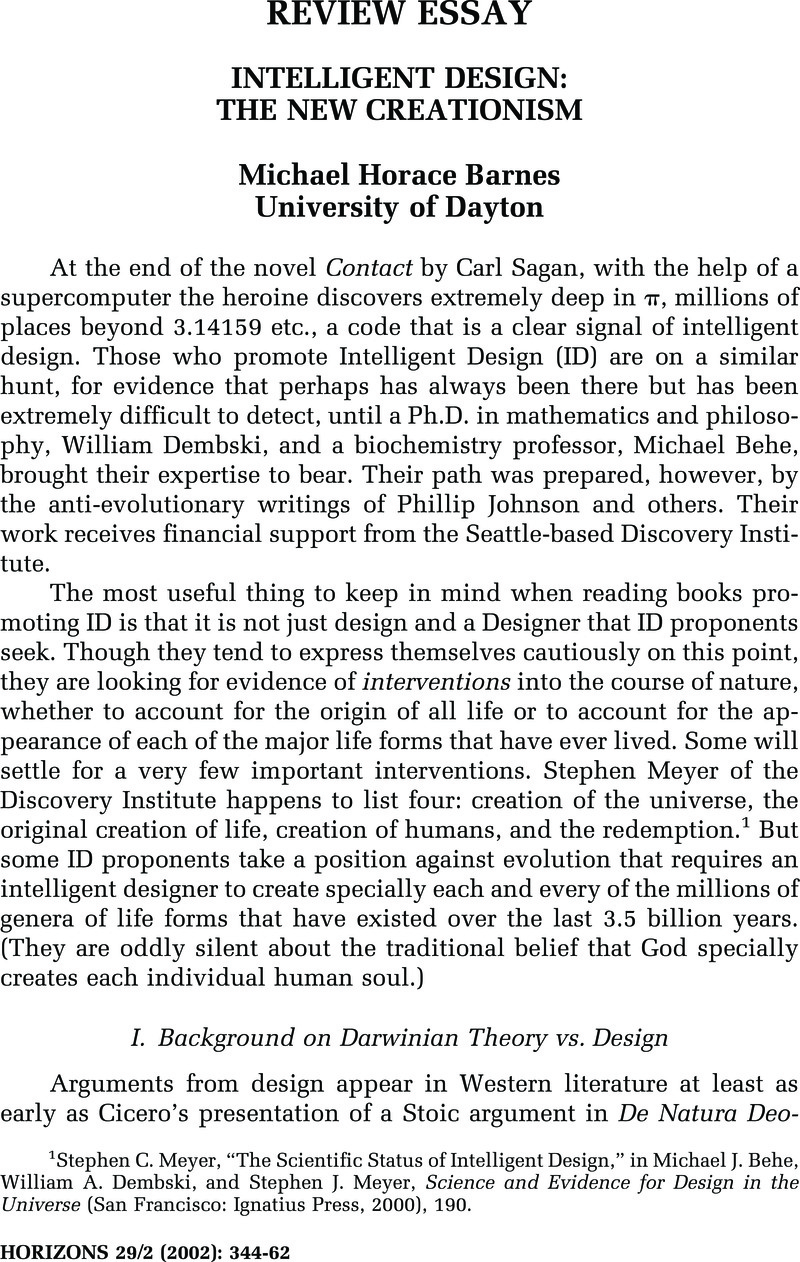Published online by Cambridge University Press: 09 September 2014

1 Meyer, Stephen C., “The Scientific Status of Intelligent Design,” in Behe, Michael J., Dembski, William A., and Meyer, Stephen J., Science and Evidence for Design in the Universe (San Francisco: Ignatius Press, 2000), 190.Google Scholar
2 In fact Johnson's first work, Darwin on Trial repeats major arguments put forward by Macbeth, Norman, Darwin Retried: An Appeal to Reason (Boston: Gambit, 1971)Google Scholar, which in turn borrowed from earlier works. Denton, Michael, Evolution: A Theory in Crisis (Bethesda, MD: Adler & Adler, 1985)Google Scholar, echoes some of Macbeth, but also foreshadows ideas in Jonathan Wells’ book, The Icons of Evolution to be mentioned below. The time spent mining earlier works might more helpfully have been spent studying the relevant biological and paleontological evidence.
3 http://www.nctimes.com/~mark/bibl_science/dembski.htm, for example, is one of the many pages that contains both an analysis of Dembski's arguments and references to many other web sites doing the same
4 Dembski, William A., The Design Inference: Eliminating Chance Through Small Probabilities (New York: Cambridge University Press, 1998).CrossRefGoogle Scholar
5 Dennett, Daniel C., Darwin's Dangerous Idea : Evolution and the Meanings of Life (New York: Simon & Schuster, 1995)Google Scholar, does an excellent job of reviewing the many possible implications of the theory of natural selection.
6 Meyer, Stephen C., “Evidence for Design in Physics and Biology: From the Origin of the Universe to the Origin of Life,” in Science and Evidence for Design in the Universe, 78–82Google Scholar, joins in to say that prebiotic natural selection is a contradiction in terms. But he then provides an argument not that the notion is self-contradictory, but that the first life forms on earth require too much information input to be the result of natural selection. He misses the point of the theory of natural selection precisely as a mechanism for producing complex information.
7 A highly readable summary of relevant information on scientific speculation about possible origins of life can be found in Fortey, Richard, Life: A Natural History of the First Four Billion Years of Life on Earth (New York: Knopf, 1998).Google Scholar
8 For support for Wells go to http://www.arn.org/wells/jwhome.htm For chapter by chapter criticism of the book, go to http://www.talkorigins.org/faqs/wells/ or to http://www.nmsr.org/iconanti.htm
9 Again, http://www.ncseweb.org provides many links.
10 Meyer, , “The Scientific Status of Intelligent Design,” 190.Google Scholar
11 For an example of Behe's actual response to Miller, and others, see his article “Answering Scientific Criticisms,” in Science and Evidence for Design in the Universe, 133–47.Google Scholar
12 On blood clotting: http://www.millerandlevine.com/km/evol/DI/clot/Clotting.html. For a readable brief analysis of Behe's ideas, see http://bostonreview.mit.edu/br21.6/orr.html by H. Allen Orr.
13 Among various books with discussions of the anthropic principle, at least two of them combine it with some form of ID argument: Denton, Michael J., Nature's Destiny: How the Laws of Biology Reveal Purpose in the Universe (New York: The Free Press, 1998)Google Scholar, and Corey, Michael A., The God Hypothesis: Discovering Design in Our “Just Right” Goldilocks Universe (New York: Rowman and Littlefield, 2001).Google Scholar Both mix science and philosophical theology in somewhat awkward ways.
14 For the basis of this claim, go to http://www.reviewevolution.com/ and click on the “100 scientists …” link.
15 http://www.infidels.org/secular_web/feature/1999/wedge.html This site quotes from the Wedge Project position paper, and says that Jay Richards, CRSC Director acknowledges that this is a genuine mission statement of the CRSC.
16 Bracken's The One in the Many is metaphysically and theologically profound, and situates the personal and the social at the center of what has been a rather abstractly formal philosophical system. Haught, John, God After Darwin: A Theology of Evolution (Boulder, CO: Westview Press, 2000)Google Scholar, integrates evolution with a particular spirituality also based on process thought.
17 “Science and Christian Faith,” Theological Investigations, 21 (New York: Crossroad, 1988): 16–55, contains a brief summary of the extremely constructive response to evolution found in his Hominisation: The Evolutionary Origins of Man as a Theological Problem (New York: Herder and Herder, 1965).